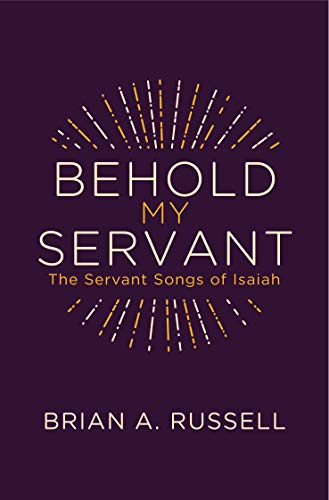A Book Review from Books At a Glance
Reviewed by Justin Denney
Like an impressive art gallery, the Servant Songs of Isaiah provide an endless source of wonder, and for Christian readers throughout history, they have served as some of the most important texts in the Old Testament. Behold My Servant: The Servant Songs of Isaiah uses the texts to shed light on Jesus’ life and ministry.
Brian Russell, born and educated in South Africa, began as a pastor in the early 1960s, and has written a handful of other books, including Totally Committed to Christ, The Greatest Prayer Ever Prayed (exposition of John 17), and Christ’s Return as King of Kings. In Behold My Servant, he takes his readers on a detailed-filled tour of Isaiah’s gallery of Servant Songs. The tour begins with a brief introduction to the Songs and their context, and then moves on to spend one chapter on each of the first three Songs and then eight chapters (126 pages) on the final Song in Isaiah 52:10-53:12.
Contents
The underlying thesis of the book is simple: each phrase of Isaiah’s four Servant Songs finds its fulfillment in the person and work of Jesus Christ. Jesus used them as the blueprint for his ministry, and the gospel writers recount how he fulfilled the prophecies of Isaiah. As such, each phrase from the Songs is ripe for reflection, and Russell explores their significance for the Christian; namely, how they can increase our knowledge of Jesus and Christian doctrine. Throughout the book, he employs a number of tools: Old Testament commentators, Puritan theologians and hymn writers, and references to Hebrew and Greek words. But all are used to show how the Songs relate to Jesus.
Each chapter introduces the passage, usually making exegetical observations from the Song. Then Russell extrapolates a number of themes, explaining their relationship to Jesus. For example, in Chapter 8, he makes exegetical observations about Isaiah 53:7, and then launches into the body of the chapter, which fall under three headings: “He was silent in obeying His Father’s will,” “He was silent in bearing people’s sin,” and “He was silent in suffering human injustice.” Russell will typically do one of three things in his main points. First, he shows how the text describes the person and work of Jesus. This represents the largest portion of the book. For example, in his point “He was silent in suffering human injustice,” Russell turns immediately to how Jesus silently suffered injustice, devoting six pages to describe the injustices in the gospel trial narratives (and citing extended passages from the gospels along the way). As Russell leads the tour, he points to detail after detail, intending to peek our admiration for Jesus and his work. Second, Russell uses the text as a springboard to talk about a Christian doctrine, such as God’s sovereignty or particular atonement. Commenting on the Servant’s silence in obeying the Father’s will, he writes, “What he learned, as the divine-human Servant, was the cost of obedience; the cost of being our sin-bearing substitute, enduring our hell so that we might be spared to enter heaven” (p.154-5). Third, he applies the text, sometimes to preachers, other times to non-Christians or lay Christians. For example, under “He was silent in bearing his people’s sin,” he calls the readers to consider the depth of Jesus’ sacrifice and the claim it makes on their lives.
Audience
The book is written as an in-depth, exegetical devotional. However, the devotional component is sometimes lost as Russell spends lots of time on details that don’t advance the devotional thrust of the text. Russell frequently dives into the meaning of a Hebrew word or syntax in ways not entirely helpful. He also belabors his points, spending several pages on a point where a paragraph would do. Consequently, the “in-depth” portions often overwhelm the devotional intent, and the appeal to laypeople and non-Christians diminishes. Instead of functioning as a devotional, it can serve as a reference for pastors, illustrating ways in which the Servant Songs can be applied to Jesus, with its line-by-line exposition and helpful quotations by the likes of Packer, Blocher, and Spurgeon.
Response
In addition to its lack of concision, the book has another significant weakness. Russell misses a large piece of how the Servant Songs are functioning. He points out a myriad of details of the Servant, but had he broadened our gaze to see the larger canvas of the Songs within the context of Isaiah, the sufferings and virtues of the Isaiah’s afflicted hero would take on deeper meaning. Russell primarily uses the songs as a lens to view both Christian doctrine and the character of Jesus, a tool to build systematic theology. But it seems Isaiah, and the gospel writers after him (Mark and Luke-Acts in particular), use the Servant Songs more often to do biblical theology. In other words, they use Isaiah less often to proof-text (although they do some of it) and more often to set the agenda for their entire works, showing how God’s redemptive plan is unfolding in Jesus, surprising, rebuking, and regenerating us, making us new people with a new set of loves and new way of seeing the world. Of course, this redemptive work has profound implications for systematic theology. But by skipping over biblical theology, one can overlook the overarching purpose of the Songs.
On the whole, Behold My Servant contains a number of heart-warming depictions of the Savior, but one must be willing to wade through the details to get them.
Justin Denney (M.Div., Trinity Evangelical Divinity School) is on the pastoral staff at CrossWay Community Church, Bristol, WI.
